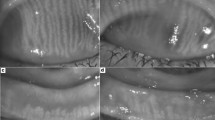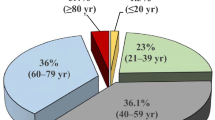Abstract
Purpose
To evaluate the signs and symptoms of dry eye in healthy pregnant women and investigate the effect of pregnancy on meibomian gland loss using non-contact meibography.
Methods
Healthy pregnant women and age-matched healthy non-pregnant women were included in the study. Subjective symptoms were assessed using the Ocular Surface Disease Index (OSDI). The first and average non-invasive break-up times (first-NIBUT and avg-NIBUT, respectively) were determined, and the Schirmer test was applied. Non-contact meibography was performed.
Results
The study included a total of 62 women, 30 pregnant (study group) and 32 non-pregnant (control group). There was no significant difference between the groups in terms of OSDI score and the Schirmer test (p > 0.05). The mean first-NIBUT and avg-NIBUT values of the study group (13.1 ± 5.3 and 13.7 ± 4.5 s) were significantly lower than the control group (16.0 ± 2.4 and 16.4 ± 1.5 s) (p: 0.015 and p: 0.040, respectively). The mean meibomian gland losses in the upper and lower eyelids were significantly higher in the study group (16.9 ± 8.2% and 11.6 ± 10.2%) compared to the control group (9.7 ± 6.2% and 5.6 ± 4.7%) (p < 0.001 and p: 0.011, respectively).
Conclusions
It is considered that loss of the meibomian glands may occur during pregnancy, and this may predispose pregnant women to evaporative dry eye. Although dry eye does not cause significant ocular surface symptoms in pregnancy, NIBUT and non-contact meibography can be considered as effective diagnostic methods for the detection of dry eye in pregnant women.



Similar content being viewed by others
References
Garg P, Aggarwal P (2012) Ocular changes in pregnancy. Nepal J Ophthalmol 4:150–161. https://doi.org/10.3126/nepjoph.v4i1.5867
Samra KA (2013) The eye and visual system in pregnancy, what to expect? An in-depth review. Oman J Ophthalmol 6:87–91. https://doi.org/10.4103/0974-620X.116626
Lemp MA, Crews LA, Bron AJ, Foulks GN, Sullivan BD (2012) Distribution of aqueous-deficient and evaporative dry eye in a clinic-based patient cohort: a retrospective study. Cornea 31:472–478. https://doi.org/10.1097/ICO.0b013e318225415a
Arita R, Itoh K, Inoue K, Amano S (2008) Noncontact infrared meibography to document age-related changes of the meibomian glands in a normal population. Ophthalmology 115:911–915. https://doi.org/10.1016/j.ophtha.2007.06.031
Finis D, Pischel N, Schrader S, Geerling G (2013) Evaluation of lipid layer thickness measurement of the tear film as a diagnostic tool for Meibomian gland dysfunction. Cornea 32:1549–1553. https://doi.org/10.1097/ICO.0b013e3182a7f3e1
Pult H, Nichols JJ (2012) A review of meibography. Optom Vis Sci 89:E760–E769. https://doi.org/10.1097/OPX.0b013e3182512ac1
Nkiru ZN, Stella O, Udeh N, Polycarp UA, Daniel CN, Ifeoma RE (2019) Dry eye disease: a longitudinal study among pregnant women in Enugu, south east, Nigeria. Ocul Surf 17:458–463. https://doi.org/10.1016/j.jtos.2019.05.001
Truong S, Cole N, Stapleton F, Golebiowski B (2014) Sex hormones and the dry eye. Clin Exp Optom 97:324–336. https://doi.org/10.1111/cxo.12147
Rizyal A, Shrestha B, Khadka A (2020) Dry eye disease among pregnant women at a tertiary care hospital in Kathmandu. Nep Med Coll J 22:146–152
Wong J, Ding C, Yiu S, Smith R, Goodwin T, Schechter J (2004) An epidemiological study of pregnancy and dry eye. Ocul Surf 3(Supp 1):127
Ibraheem WA, Ibraheem AB, Tjani AM, Oladejo S, Adepoju S, Folohunso B (2015) Tear film functions and intraocular pressure changes in pregnancy. Afr J Reprod Health 19:118–122
Skare TL, Gehlen ML, Silveira DM, Uema MM (2012) Gravidez e disfunção lacrimal [Lacrimal dysfunction and pregnancy]. Rev Bras Ginecol Obstet 34:170–174. https://doi.org/10.1590/s0100-72032012000400006
Asiedu K, Kyei S, Adanusa M, Ephraim RKD, Animful S, Ali-Baya SK, Akorsah B, Sekyere MA (2021) Dry eye, its clinical subtypes and associated factors in healthy pregnancy: a cross-sectional study. PLoS One 16:e0258233. https://doi.org/10.1371/journal.pone.0258233
Schechter JE, Pidgeon M, Chang D, Fong YC, Trousdale MD, Chang N (2002) Potential role of disrupted lacrimal acinar cells in dry eye during pregnancy. Adv Exp Med Biol 506(Pt A):153–157. https://doi.org/10.1007/978-1-4615-0717-8_20
Ding C, Lu M, Huang J (2011) Changes of the ocular surface and aquaporins in the lacrimal glands of rabbits during pregnancy. Mol Vis 17:2847–2855
Sarikaya S, Acet Y (2022) The effect of pregnancy on meibomian gland, tear film, cornea and anterior segment parameters. Photodiag Photodyn Ther 40:103070
Acknowledgements
Our research was not funded by any organization.
Funding
The authors declare that no funds, grants, or other support were received during the preparation of this manuscript.
Author information
Authors and Affiliations
Contributions
All authors contributed to the study conception and design. Conceived and designed the analysis was performed by MSK. Data collection was performed by MSK, AK, and ÇH. Data contribution or analysis was perfomed by ÇH, GKH, and BİSA. The first draft of the manuscript was written by FK, GKH, and BİSA and all authors commented on previous versions of the manuscript. All authors read and approved the final manuscript.
Corresponding author
Ethics declarations
Conflict of interest
The authors have no proprietary interests or conflicts of interest related to this submission.
Ethical approval
The study was approved by Ethics Committee of Umraniye Educational and Research Hospital.
Consent to participate
Informed consent was obtained from all individual participants included in the study.
Additional information
Publisher's Note
Springer Nature remains neutral with regard to jurisdictional claims in published maps and institutional affiliations.
Rights and permissions
Springer Nature or its licensor (e.g. a society or other partner) holds exclusive rights to this article under a publishing agreement with the author(s) or other rightsholder(s); author self-archiving of the accepted manuscript version of this article is solely governed by the terms of such publishing agreement and applicable law.
About this article
Cite this article
Kunduracı, M.S., Koçkar, A., Helvacıoğlu, Ç. et al. Evaluation of dry eye and meibomian gland function in pregnancy. Int Ophthalmol 43, 4263–4269 (2023). https://doi.org/10.1007/s10792-023-02836-6
Received:
Accepted:
Published:
Issue Date:
DOI: https://doi.org/10.1007/s10792-023-02836-6




